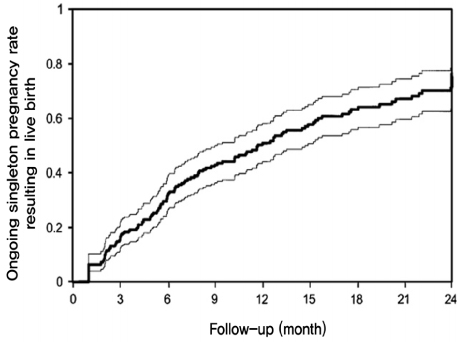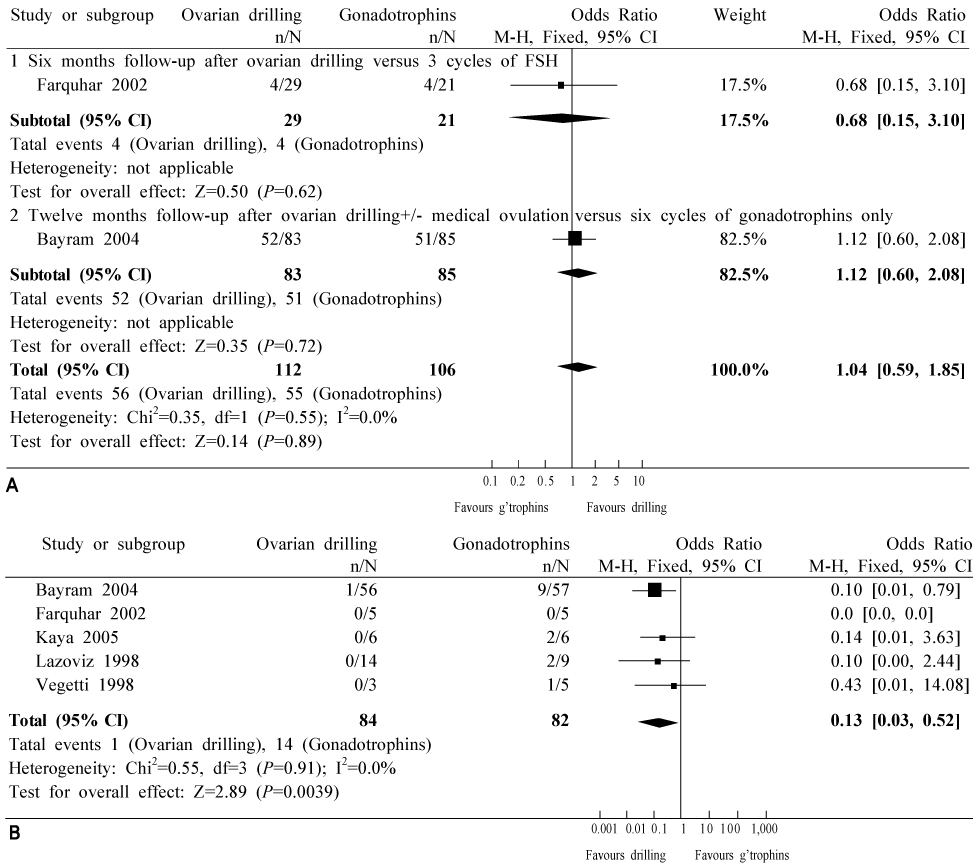Korean J Obstet Gynecol.
2010 Oct;53(10):869-880. 10.5468/kjog.2010.53.10.869.
The infertility treatment related with polycystic ovary syndrome
- Affiliations
-
- 1Department of Obstetrics and Gynecology, Pusan National University College of Medicine, Busan, Korea. yjna@pusan.ac.kr
- KMID: 1453751
- DOI: http://doi.org/10.5468/kjog.2010.53.10.869
Abstract
- The treatment of infertile women with polycystic ovary syndrome (PCOS) has not yet been established. Before any intervention is initiated, lifestyle modification with diet and exercise leading to weight loss should be emphasized in overweight women. The recommended first-line treatment for ovulation induction remains clomiphene citrate. If clomiphene citrate use fails to result in ovulation or pregnancy, the recommended second-line intervention is exogenous gonadotropins. The use of exogenous gonadotropins is related to an increased risk for multiple pregnancies, and, therefore, intense ovarian response monitoring is required. Laparoscopic ovarian surgery is an alternative to gonadotropin therapy because this surgery is as effective as gonadotropin in pregnancy rate or live birth rate. However, the surgery may require additional ovulation induction drug and should be performed by well-trained surgeon, its use solely to induce ovulation is unwarranted. Recommended third-line treatment is in vitro fertilization (IVF). IVF reduces the risk of multiple pregnancies by using single-embryo transfer in women with PCOS. The use of metformin alone as first-line infertility therapy or in combination with clomiphene is surrounded by controversies. Aromatase inhibitors appear to be as effective as clomiphene citrate for induction of ovulation, but the drug is currently not approved for treatment of infertility. Further studies should demonstrate the efficacy and long term safety.
MeSH Terms
Figure
Cited by 1 articles
-
Factors Influencing Infertility-related Quality of Life in Women Undergoing Assisted Reproductive Techniques: Focusing on Depression and Resilience
You Jung Jung, Hye Young Kim
Korean J Women Health Nurs. 2017;23(2):117-125. doi: 10.4069/kjwhn.2017.23.2.117.
Reference
-
1. Stein IF, Leventhal ML. Amenorrhoea associated with bilateral polycystic ovaries. Am J Obstet Gynecol. 1935. 29:181–191.2. The Rotterdam ESHRE/ASRM sponsored PCOS consensus workshop group. Revised 2003 consensus on diagnostic criteria and long-term health risks related to polycystic ovary syndrome. Fertil Steril. 2004. 81:19–25.3. Practice Committee of the American Society for Reproductive Medicine. Use of insulin-sensitizing agents in the treatment of polycystic ovary syndrome. Fertil Steril. 2008. 90:5 Suppl. S69–S73.4. The Thessalonoki ESHRE/ASRM sponsored PCOS consensus workshop group. Consensus on infertility treatment related to polycystic ovary syndrome. Fertil Steril. 2008. 89:505–522.5. Moran LJ, Noakes M, Clifton PM, Tomlinson L, Galletly C, Norman RJ. Dietary composition in restoring reproductive and metabolic physiology in overweight women with polycystic ovary syndrome. J Clin Endocrinol Metab. 2003. 88:812–819.6. Kiddy DS, Hamilton-Fairley D, Bush A, Short F, Anyaoku V, Reed MJ, et al. Improvement in endocrine and ovarian function during dietary treatment of obese women with polycystic ovary syndrome. Clin Endocrinol (Oxf). 1992. 36:105–111.7. Tsagareli V, Noakes M, Norman RJ. Effect of a very-low-calorie diet on in vitro fertilization outcomes. Fertil Steril. 2006. 86:227–229.8. Stamets K, Taylor DS, Kunselman A, Demers LM, Pelkman CL, Legro RS. A randomized trial of the effects of two types of short-term hypocaloric diets on weight loss in women with polycystic ovary syndrome. Fertil Steril. 2004. 81:630–637.9. Reaven GM. The insulin resistance syndrome: definition and dietary approaches to treatment. Annu Rev Nutr. 2005. 25:391–406.10. Wright CE, Zborowski JV, Talbott EO, McHugh-Pemu K, Youk A. Dietary intake, physical activity, and obesity in women with polycystic ovary syndrome. Int J Obes Relat Metab Disord. 2004. 28:1026–1032.11. Jayagopal V, Kilpatrick ES, Holding S, Jennings PE, Atkin SL. Orlistat is as beneficial as metformin in the treatment of polycystic ovarian syndrome. J Clin Endocrinol Metab. 2005. 90:729–733.12. Sabuncu T, Harma M, Nazligul Y, Kilic F. Sibutramine has a positive effect on clinical and metabolic parameters in obese patients with polycystic ovary syndrome. Fertil Steril. 2003. 80:1199–1204.13. Imani B, Eijkemans MJ, te Velde ER, Habbema JD, Fauser BC. A nomogram to predict the probability of live birth after clomiphene citrate induction of ovulation in normogonadotropic oligoamenorrheic infertility. Fertil Steril. 2002. 77:91–97.14. Eijkemans MJ, Imani B, Mulders AG, Habbema JD, Fauser BC. High singleton live birth rate following classical ovulation induction in normogonadotrophic anovulatory infertility (WHO 2). Hum Reprod. 2003. 18:2357–2362.15. Legro RS, Barnhart HX, Schlaff WD, Carr BR, Diamond MP, Carson SA, et al. Clomiphene, metformin, or both for infertility in the polycystic ovary syndrome. N Engl J Med. 2007. 356:551–566.16. Kosmas IP, Tatsioni A, Fatemi HM, Kolibianakis EM, Tournaye H, Devroey P. Human chorionic gonadotropin administration vs. luteinizing monitoring for intrauterine insemination timing, after administration of clomiphene citrate: a meta-analysis. Fertil Steril. 2007. 87:607–612.17. Messinis IE. Ovulation induction: a mini review. Hum Reprod. 2005. 20:2688–2697.18. Kousta E, White DM, Franks S. Modern use of clomiphene citrate in induction of ovulation. Hum Reprod Update. 1997. 3:359–365.19. Kolibianakis EM, Zikopoulos KA, Fatemi HM, Osmanagaoglu K, Evenpoel J, Van Steirteghem A, et al. Endometrial thickness cannot predict ongoing pregnancy achievement in cycles stimulated with clomiphene citrate for intrauterine insemination. Reprod Biomed Online. 2004. 8:115–118.20. Palomba S, Falbo A, Zullo F. Management strategies for ovulation induction in women with polycystic ovary syndrome and known clomifene citrate resistance. Curr Opin Obstet Gynecol. 2009. 21:465–473.21. Daly DC, Walters CA, Soto-Albors CE, Tohan N, Riddick DH. A randomized study of dexamethasone in ovulation induction with clomiphene citrate. Fertil Steril. 1984. 41:844–848.22. Mitwally MF, Casper RF. Use of an aromatase inhibitor for induction of ovulation in patients with an inadequate response to clomiphene citrate. Fertil Steril. 2001. 75:305–309.23. Biljan MM, Hemmings R, Brassard N. The outcome of 150 babies following the treatment with letrozole or letrozole and gonadotropins. Fertil Steril. 2005. 84:Suppl 1. S95.24. Elizur SE, Tulandi T. Drugs in infertility and fetal safety. Fertil Steril. 2008. 89:1595–1602.25. Tulandi T, Martin J, Al-Fadhli R, Kabli N, Forman R, Hitkari J, et al. Congenital malformations among 911 newborns conceived after infertility treatment with letrozole or clomiphene citrate. Fertil Steril. 2006. 85:1761–1765.26. Tang T, Glanville J, Hayden CJ, White D, Barth JH, Balen AH. Combined lifestyle modification and metformin in obese patients with polycystic ovary syndrome. A randomized, placebo-controlled, double-blind multicentre study. Hum Reprod. 2006. 21:80–89.27. Harborne L, Fleming R, Lyall H, Norman J, Sattar N. Descriptive review of the evidence for the use of metformin in polycystic ovary syndrome. Lancet. 2003. 361:1894–1901.28. Moll E, Bossuyt PM, Korevaar JC, Lambalk CB, van der Veen F. Effect of clomifene citrate plus metformin and clomifene citrate plus placebo on induction of ovulation in women with newly diagnosed polycystic ovary syndrome: randomised double blind clinical trial. BMJ. 2006. 332:1485.29. Nestler JE. Metformin in the treatment of infertility in polycystic ovarian syndrome: an alternative perspective. Fertil Steril. 2008. 90:14–16.30. Tang T, Lord JM, Norman RJ, Yasmin E, Balen AH. Insulin-sensitising drugs (metformin, rosiglitazone, pioglitazone, D-chiro-inositol) for women with polycystic ovary syndrome, oligo amenorrhoea and subfertility. Cochrane Database Syst Rev. 2010. CD003053.31. Christin-Maitre S, Hugues JN. A comparative randomized multicentric study comparing the step-up versus step-down protocol in polycystic ovary syndrome. Hum Reprod. 2003. 18:1626–1631.32. Balen AH, Tan SL, Jacobs HS. Hypersecretion of luteinising hormone: a significant cause of infertility and miscarriage. Br J Obstet Gynaecol. 1993. 100:1082–1089.33. Calaf Alsina J, Ruiz Balda JA, Romeu arrio A, Caballero Fernandez V, Cano Trigo I, Gomez Parga JL, et al. Ovulation induction with a starting dose of 50 IU of recombinant follicle stimulating hormone in WHO group II anovulatory women: the IO-50 study, a prospective, observational, multicentre, open trial. BJOG. 2003. 110:1072–1077.34. Homburg R, Howles CM. Low-dose FSH therapy for anovulatory infertility associated with polycystic ovary syndrome: rationale, results, reflections and refinements. Hum Reprod Update. 1999. 5:493–499.35. Hugues JN, Cedrin-Durnerin I, Howles CM, Amram M, Angelini A, Balen A, et al. The use of a decremental dose regimen in patients treated with a chronic low-dose step-up protocol for WHO Group II anovulation: a prospective randomized multicentre study. Hum Reprod. 2006. 21:2817–2822.36. Practice Committee of the American Society for Reproductive Medicine. Ovarian hyperstimulation syndrome. Fertil Steril. 2006. 86:5 Suppl 1. S178–S183.37. Balasch J, Tur R, Alvarez P, Bajo JM, Bosch E, Bruna I, et al. The safety and effectiveness of stepwise and low-dose administration of follicle stimulating hormone in WHO group II anovulatory infertile women: evidence from a large multicenter study in Spain. J Assist Reprod Genet. 1996. 13:551–556.38. Hamilton-Fairley D, Franks S. Common problems in induction of ovulation. Baillieres Clin Obstet Gynaecol. 1990. 4:609–625.39. Hendriks ML, Ket JC, Hompes PG, Homburg R, Lambalk CB. Why does ovarian surgery in PCOS help? Insight into the endocrine implications of ovarian surgery for ovulation induction in polycystic ovary syndrome. Hum Reprod Update. 2007. 13:249–264.40. Amer SA, Li TC, Cooke ID. A prospective dose-finding study of the amount of thermal energy required for laparoscopic ovarian diathermy. Hum Reprod. 2003. 18:1693–1698.41. Malkawi HY, Qublan HS, Hamaideh AH. Medical vs. surgical treatment for clomiphene citrate-resistant women with polycystic ovary syndrome. J Obstet Gynaecol. 2003. 23:289–293.42. Farquhar C, Lilford RJ, Marjoribanks J, Vandekerckhove P. Laparoscopic 'drilling' by diathermy or laser for ovulation induction in anovulatory polycystic ovary syndrome. Cochrane Database Syst Rev. 2007. CD001122.43. Gurgan T, Urman B, Aksu T, Yarali H, Develioglu O, Kisnisci HA. The effect of short-interval laparoscopic lysis of adhesions on pregnancy rates following Nd-YAG laser photocoagulation of polycystic ovaries. Obstet Gynecol. 1992. 80:45–47.44. Greenblatt EM, Casper RF. Adhesion formation after laparoscopic ovarian cautery for polycystic ovarian syndrome: lack of correlation with pregnancy rate. Fertil Steril. 1993. 60:766–770.45. Amer SA, Banu Z, Li TC, Cooke ID. Long-term follow-up of patients with polycystic ovary syndrome after laparoscopic ovarian drilling: endocrine and ultrasonographic outcomes. Hum Reprod. 2002. 17:2851–2857.46. Eijkemans MJ, Polinder S, Mulders AG, Laven JS, Habbema JD, Fauser BC. Individualized cost-effective conventional ovulation induction treatment in normogonadotrophic anovulatory infertility (WHO group 2). Hum Reprod. 2005. 20:2830–2837.47. Al-Inany HG, Abou-Setta AM, Aboulghar M. Gonadotrophin-releasing hormone antagonists for assisted conception. Cochrane Database Syst Rev. 2006. 3:CD001750.48. Tso LO, Costello MF, Albuquerque LE, Andriolo RB, Freitas V. Metformin treatment before and during IVF or ICSI in women with polycystic ovary syndrome. Cochrane Database Syst Rev. 2009. CD006105.49. Heijnen EM, Eijkemans MJ, Hughes EG, Laven JS, Macklon NS, Fauser BC. A meta-analysis of outcomes of conventional IVF in women with polycystic ovary syndrome. Hum Reprod Update. 2006. 12:13–21.50. van Rumste MM, Custers IM, van der Veen F, van Wely M, Evers JL, Mol BW. The influence of the number of follicles on pregnancy rates in intrauterine insemination with ovarian stimulation: a meta-analysis. Hum Reprod Update. 2008. 14:563–570.51. Albano C, Platteau P, Nogueira D, Cortvrindt R, Smitz J, Devroey P. Avoidance of multiple pregnancies after ovulation induction by supernumerary preovulatory follicular reduction. Fertil Steril. 2001. 76:820–822.52. Haydardedeoglu B, Bagis T, Simsek E, Cok T, Hacivelioglu SO, Erkanli S. The impact of rescue in vitro fertilization converted from high-response gonadotropin intrauterine insemination cycles in terms of implantation and pregnancy rates as compared with matched controls. Fertil Steril. 2009. 92:137–142.



